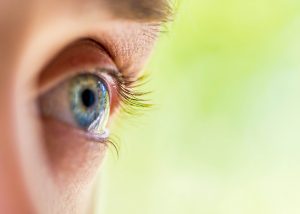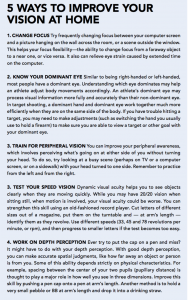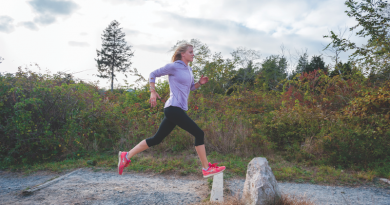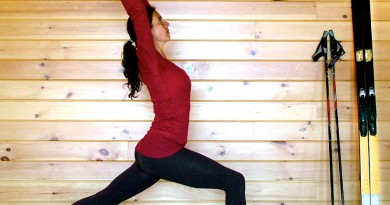The New Type Of Strength Training
When you’re an athlete, every move you make starts with your eyes. With the right exercises, you can improve your vision and performance. Here’s how.
If you’re flying through backcountry on a powder day, navigating slalom gates, ascending a wall of ice or negotiating rapids in a kayak, strength is important. Most athletes dedicate time and effort to the size and power of muscles specific to their sport: skiers squat for their quads, kayakers work their core and arms, climbers gain grip strength.
But most athletes neglect to train what is, perhaps, the most important muscle of all: the eye.
“The whole computerized network called the human body works like this,” says pioneering sports vision specialist Donald Teig, who has worked with Olympic athletes and big-league national baseball, football and hockey teams. “Eighty percent of the information you get about your senses comes through your eyes. The eyes send those messages to your brain, and then the brain tells your muscular system how to react or move in a certain way that achieves the goal.”
 It seems obvious: With poor eyesight, a slalom skier will misjudge the gate’s location and turn too early or late, a baseball player may strike out or a golfer will miss a hole. Many athletes turn to prescription eye glasses, contact lenses or surgery to improve vision. But more and more, doctors are telling athletes that the eye, just like any other muscle, can be trained.
It seems obvious: With poor eyesight, a slalom skier will misjudge the gate’s location and turn too early or late, a baseball player may strike out or a golfer will miss a hole. Many athletes turn to prescription eye glasses, contact lenses or surgery to improve vision. But more and more, doctors are telling athletes that the eye, just like any other muscle, can be trained.
How It Works
The idea that you can train your eye and, in turn, expect better performance, is part of a new and growing field with the laborious title “visual neurocognitive motor training.” While vision training may not reverse your nearsightedness, farsightedness or astigmatism, it has been shown to dramatically improve certain visual skills: depth perception, peripheral vision field awareness, hand-eye coordination, contrast sensitivity, and even balance.
Teig, who is now based out of Florida, has trained a network of more than optometrists across the country (including two in the Northeast) that he calls the “A Team,” who provide sports vision training. He’s worked with 15 Major League Baseball teams, several National Hockey League Teams, Olympic ski racers, football players, ballerinas—the list goes on.
“In the past three years, there’s been a tremendous reaching out, at least to me, about this whole field,” Teig says. “This has become the hottest new area for an athlete to gain a competitive edge.”
In the 1990’s, Teig worked with the U.S. Ski Team, and with ski legends like Tommy Moe to improve balance and reaction time. The skier stood on a balancing device in front of a screen. When an arrow pointing right was projected onto the screen, the skier would have to shift their weight to the right as quickly and as accurately as they could. Then, another arrow would come up, and point forward or back.
“What you’re trying to do is make that transfer between what your eye is telling you and what your balance system needs to do, and do it as fast as you can, let’s say over a one-minute period,” he says. “The training is geared at giving athletes quicker and more accurate decision-making skills. That’s what this is about.”
Visual training comes in many shapes and sizes. A typical visit to a sports vision specialist is like a consultation with a physical therapist; you will be tested, the doctor will help develop a plan to improve your vision, and you will walk away with a prescribed regimen of exercises to practice at home.
But don’t expect it to be your run-of-the-mill eye exam. Walk into optometrist Thomas Clark’s exam room in Williston, Vt. expecting the Snellen test—the chart with lines of big letters at the top and tiny letters at the bottom that determines whether you have 20/20 vision—and you’re in for something a bit more dynamic. While Clark has all the usual ocular gadgets—retinal cameras, retinoscopes, slit lamps—he also has a long string adorned with colorful, spherical beads, called the Brock String.
He’ll instruct you to hold the string to your nose and look down it. When you do, you’ll discover that there appear to be two strings in front of your face, and they cross like an ‘x’ at the point where your eyes focus. Clark, who advised national shooting teams as a captain and optometrist in the Army, will instruct you to look at the pink bead, then the green bead, then the orange, and as you do, the ‘x’ will change shape, growing either longer or shorter on either end. This is an exercise that vision specialists use to help you strengthen your ocular muscle balance; while using both eyes to make the ‘x’, your eyes are fortifying their relationship to each other.
“The more muscle imbalance you have, the harder it is to be a good athlete, especially at a high level,” Clark says. “Almost everyone has a small level of muscle imbalance. But in baseball, the difference between hitting 291 and hitting 301 is two million dollars.”
Exercises like the Brock String physically strengthen the eye and the brain’s connection to it. When an athlete repeats these exercises, he or she can quicken the pace and efficiency of the electrical impulses that the eye sends to the brain. The more you practice, the more efficient those electrical signals become.
As the field grows, researchers are developing more ways to test and improve upon the success of vision training. In 2014, psychologist Aaron Seitz and his team at the University of California Riverside gave 19 players on the university’s baseball team 30 25-minute sessions of vision training using an app he created, called UltimEyes.
The results were profound: on average, players who used the app experienced a 31 percent improvement in visual acuity—meaning they performed better on a Snellen test. Seven of the players dropped to 20/7.5 vision, which means that at 20 feet away, they could read a line that most can read from only 7.5 feet away.
Seitz also saw the team score 41 more runs than expected and win five more games than they were projected to at the beginning of the season. Trained players had 4.4 percent fewer strikeouts, and generally, the team saw better numbers for batting averages, slugging percentages, on-base percentages and walks.
Teig has seen individual success, too. “I remember a baseball player who was really struggling, and it turned out that one of his eyes wasn’t working in sync with the other eye well enough to give him a high level of depth perception,” he said. “So we corrected the vision—we put on a contact lens—but we also started training his eyes to work together better as a team. He wound up leading his Minor League team in batting that year. He upped his batting average by a hundred points. We get those things all the time.”
Because of the eye’s direct connection with the brain, those quick decision-making skills can also be augmented by visualization, or the practice of imagining, for example, a slalom course prior to skiing it. In the ‘90s, when Teig was providing optometric advice to the US Ski Team, he instructed skiers waiting for their race to “ski” the course in their minds, vividly picturing the turns, bumps and icy patches.
Other Olympic athletes, like biathletes Susan Dunklee and Lowell Bailey, say that visualization helps them feel prepared on a course, and that preparedness can make all the difference. When Bailey won the Biathlon Worlds in February of 2017—the first time an American has ever medaled at Worlds—he told TeamUSA.org that he credited visualization.
“In a sense, I had raced that 20K ten—if not hundreds—of times before I actually got to the starting line for the actual race,” he said.
An Ounce Of Protection
While vision training provides you with a solid anatomical foundation, it’s also important to consider equipment for both protection and performance enhancement.
We’ve all heard the risks of exposing our eyes to UV light: cataracts, eye growths and in extreme cases, cancer. Skiers, riders, mountaineers and ice climbers are particularly at risk from snow blindness, which occurs when the UV rays are reflected from snow or ice into your eyes. It causes alarming side-effects like blurred vision, watery eyes and swelling.
In the 2004 Iditarod, four-time champion Doug Swingley succumbed to snow blindness when he  removed his goggles for mere minutes to get a clearer look ahead. His condition was so severe that a specialist based in Anchorage advised him not to continue, and Swingley forfeited the race.
removed his goggles for mere minutes to get a clearer look ahead. His condition was so severe that a specialist based in Anchorage advised him not to continue, and Swingley forfeited the race.
How do you make sure that doesn’t happen to you? For starters, make sure you have a pair of goggles that you don’t have to remove. While all sunglasses legally sold in the U.S., considered medical devices and thereby regulated by the FDA, will give you 100 percent UV protection, some work better for competitive performance.
Nick Yardley, CEO of Vermont-based Julbo, emphasizes using goggles with a photochromatic lens, whose lightness level adjusts automatically to your environment, to avoid switching lenses during the day. Julbo’s Zebra lens adjusts to your surroundings in 20 seconds, and lenses by Zeal and Slate offer similar models.
“If we’re skinning up Mad River in the morning and skiing down in the afternoon, you might be going up in bright light and coming down in thick clouds,” Yardley says. “The standard goggle is not going to be able to adjust to those changing conditions. So at some point of the day, you’re going to have a sub-performing pair of goggles through which you’re going to have to see what’s going on with the light and the terrain.”
Or think about cross-country skiing on a trail through shaded woods that opens up into a sunny meadow. With a photochromatic lens, you wouldn’t have to worry about taking glasses or goggles off to see more clearly in forested areas. It thereby eliminates two safety concerns: risk of UV exposure, and the odds that you’ll get poked in the eye by a low-lying branch.
And the right pair of glasses can help an athlete with depth perception, give them more access to their peripheral vision, and protect against fog. For example, Yardley advises against polarized lenses while skiing, because they tend to flatten terrain. “People use ‘polarized’ as a catch-all, saying that if a lens is polarized, that means it’s automatically better, but in a ski situation on the East Coast it’s actually inferior,” he says.
While athletes often think about their boots, skis, or other gear, Yardley emphasizes that without good vision, everything else is lost.
“When you’re a performance athlete, everything that you do, whether you turn left, right, whether you miss the tree, whether you go slow, is based on what you’re perceiving through your eyes,” Yardley says. “Allowing them to have maximum visibility of the surrounding terrain is a performance-enhancing tool.”
Top photo: Nick Yardley, CEO of the Vermont-based eyewear company Julbo (pictured ice climbing), uses photochromatic lenses to avoid switching glasses and goggles during the day. Photo courtesy of Nick Yardley




